传统IO
这里以文件输入输出流:FileInputStream 、 FileOutputStream 来进行解释。由继承关系得知,这两个输入和输出类继承自 InputStream 和 OutputStream 这两个基础的输入、输出的抽象类,这时我们可以看到当我们需要读写文件的时候,就需要创建两个流对象。原理图如下

由图中可以知道,OS 提供了 API 的接口给用户程序调用,这时我们可以将 API 接口和 OS ,比如成 C/S ,也即应用程序就是浏览器端或者桌面端程序, OS 和 API 等价于服务器,也即 Controller 接口。
public class FileInputStream extends InputStream {}
public class FileOutputStream extends OutputStream {}
抽象类描述
输入流源码
流程如下:
read(byte b[])直接调用read(byte b[], int off, int len)函数- 校验
byte数组是否为空 - 校验读取范围是否正确
- 校验读取长度
- 调用
read()函数读入一个字节 - 验证字节是否达到了文件的末尾
- 将该字节的数据保存到
b数组中 - 循环将文件的数据,逐字节的从磁盘中读入放到
b字节数组中
// 只以文件流为例
public abstract class InputStream implements Closeable {
public int read(byte b[]) throws IOException {
return read(b, 0, b.length); // 直接调用 read(byte b[], int off, int len) 函数
}
public int read(byte b[], int off, int len) throws IOException {
if (b == null) { // 校验 byte 数组是否为空
throw new NullPointerException();
} else if (off < 0 || len < 0 || len > b.length - off) { // 校验读取范围是否正确
throw new IndexOutOfBoundsException();
} else if (len == 0) { // 校验读取长度
return 0;
}
// 调用 read() 函数读入一个字节
int c = read();
if (c == -1) { // 验证字节是否达到了文件的末尾
return -1;
}
b[off] = (byte)c; // 将该字节的数据保存到 b 数组中
int i = 1;
try {
// 将文件的数据,逐字节的从磁盘中读入放到 b 字节数组中
for (; i < len ; i++) {
c = read();
if (c == -1) {
break;
}
b[off + i] = (byte)c;
}
} catch (IOException ee) {
}
return i;
}
}
输出流源码
流程如下:
write(byte b[])直接调用write(byte b[], int off, int len)函数- 校验数组不能为空
- 校验写入范围是否合理
- 校验写入的长度是否为0
- 循环将
b数组中的数据,逐个字节写入文件
public abstract class OutputStream implements Closeable, Flushable {
public void write(byte b[]) throws IOException {
write(b, 0, b.length); // 直接调用 write(byte b[], int off, int len) 函数
}
public void write(byte b[], int off, int len) throws IOException {
if (b == null) { // 校验数组不能为空
throw new NullPointerException();
} else if ((off < 0) || (off > b.length) || (len < 0) ||
((off + len) > b.length) || ((off + len) < 0)) { // 校验写入范围是否合理
throw new IndexOutOfBoundsException();
} else if (len == 0) { // 校验写入的长度是否为0
return;
}
// 循环将 b 数组中的数据,逐个字节写入文件
for (int i = 0 ; i < len ; i++) {
write(b[off + i]);
}
}
}
文件输入流和输出流复写抽象类方法原理
FileInputStream 复写抽象类方法原理
FileInputStream 流程如下:
read(byte b[])方法直接调用readBytes(byte b[], int off, int len)方法read(byte b[], int off, int len)方法直接调用readBytes(byte b[], int off, int len)方法- 可以看到
readBytes(byte b[], int off, int len)方法为native,称之为JNI (Java Native Interface)方法
public class FileInputStream extends InputStream {
public int read(byte b[]) throws IOException {
return readBytes(b, 0, b.length); // 直接调用 readBytes(byte b[], int off, int len) 方法
}
public int read(byte b[], int off, int len) throws IOException {
return readBytes(b, off, len); // 直接调用 readBytes(byte b[], int off, int len) 方法
}
// 可以看到该方法为 native ,称之为 JNI (Java Native Interface)方法
private native int readBytes(byte b[], int off, int len) throws IOException;
}
FileOutputStream 复写抽象类方法原理
FileOutputStream 流程如下:
write(byte b[])方法直接调用writeBytes(byte b[], int off, int len, boolean append)方法write(byte b[], int off, int len)方法直接调用writeBytes(byte b[], int off, int len, boolean append)方法- 可以看到
writeBytes(byte b[], int off, int len, boolean append)方法为native,称之为JNI (Java Native Interface)方法
public class FileOutputStream extends OutputStream {
public void write(byte b[]) throws IOException {
writeBytes(b, 0, b.length, append); // 直接调用 writeBytes(byte b[], int off, int len, boolean append) 方法
}
public void write(byte b[], int off, int len) throws IOException {
writeBytes(b, off, len, append); // 直接调用 writeBytes(byte b[], int off, int len, boolean append) 方法
}
// 可以看到该方法为 native ,称之为 JNI (Java Native Interface)方法
private native void writeBytes(byte b[], int off, int len, boolean append) throws IOException;
}
readBytes 方法与 writeBytes 底层实现原理
readBytes 方法,关键流程如下:
malloc分配一片空间- 调用
read函数读取数据 - 将数据保存放入堆内存的
bytes数组中
原理图如下所示:
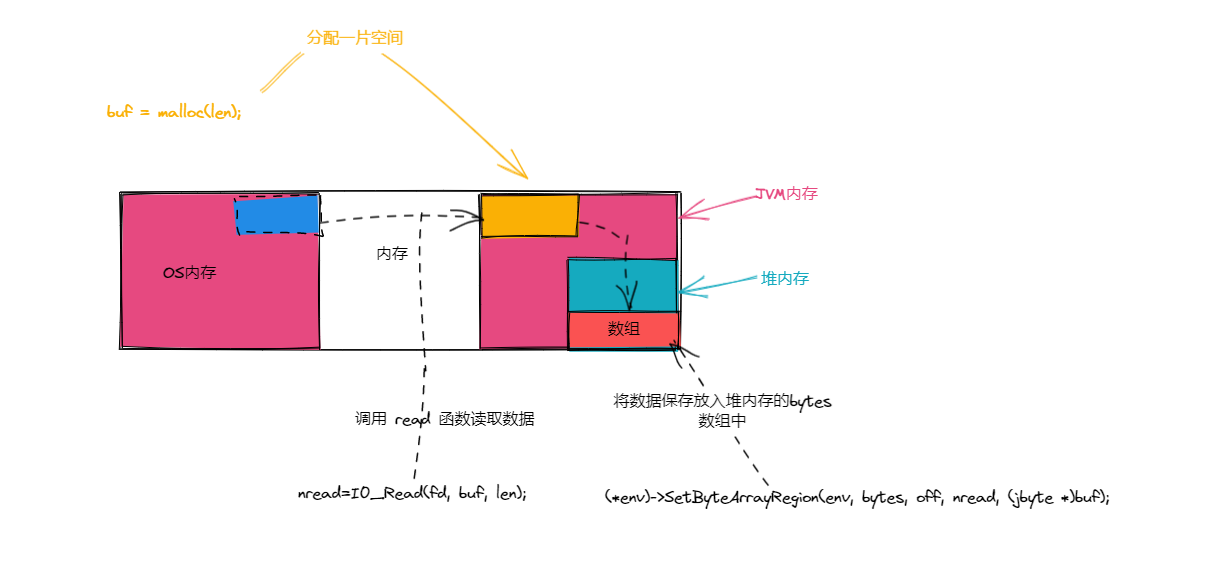
jint readBytes(JNIEnv *env, jobject this, jbyteArray bytes, jint off, jint len, jfieldID fid){
if(len==0){
return 0;
else if (len BUF_SIZE){
buf = malloc(len); // 分配一片空间
}
...
if(fd=-1){
...
} else {
nread=I0_Read(fd, buf, len); // 调用 read 函数读取数据
if (nread 0){
// 将数据保存放入堆内存的 bytes 数组中
(*env)->SetByteArrayRegion(env, bytes, off, nread, (jbyte *)buf);
}
...
}
...
}
writeBytes 方法,关键流程如下:
- 分配一片空间
- 将
java堆内存空间中的 bytes 数组中的内容复制到buf中 - 将
buf中的数据写入到 OS 中
原理图如下所示:
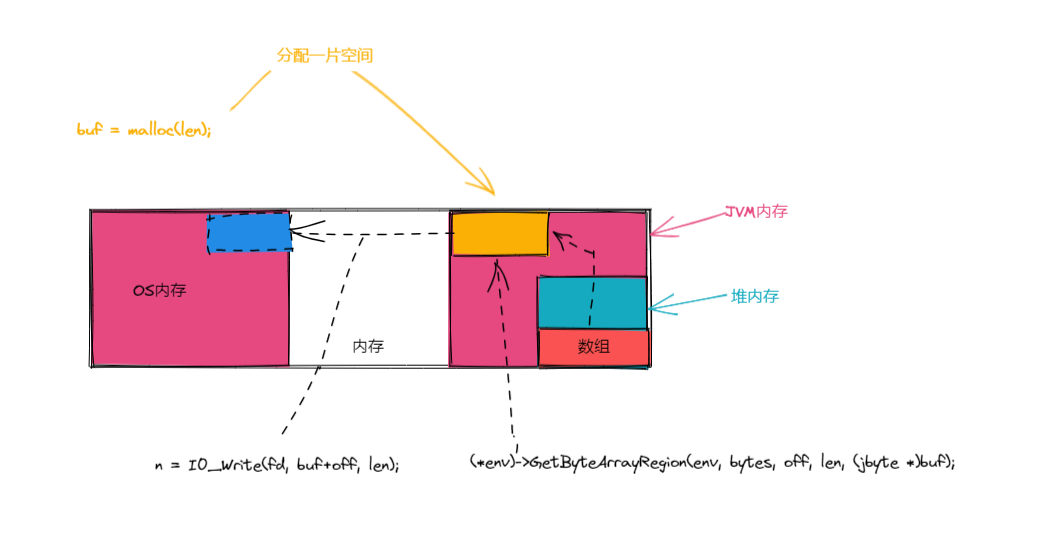
void writeBytes(JNIEnv *env, jobject this, jbyteArray bytes, jint off, jint len, jboolean append, jfieldID fid) {
...
if(len == 0) {
return;
} else if (len > BUF_SIZE) {
buf = malloc(len); // 分配一片空间
...
}
...
// 将 java 堆内存空间中的 bytes 数组中的内容复制到 buf 中
(*env)->GetByteArrayRegion(env, bytes, off, len, (jbyte *)buf);
if (!(*env)->ExceptionOccurred(env)) {
off = 0;
...
while (1en 0){
...
if (append = JNI_TRUE) {
...
} else {
n = I0_Write(fd, buf+off, len); // 将 buf 中的数据写入到 OS 中
}
...
}
}
...
}
NIO 模型
如图所示,如果我们使用普通的 IO 操作,这时我们要完成输入输出对象时,就需要创建两个对象:输入流、输出流,同时我们在传输时面向的数据为字节数据,也即字节流。
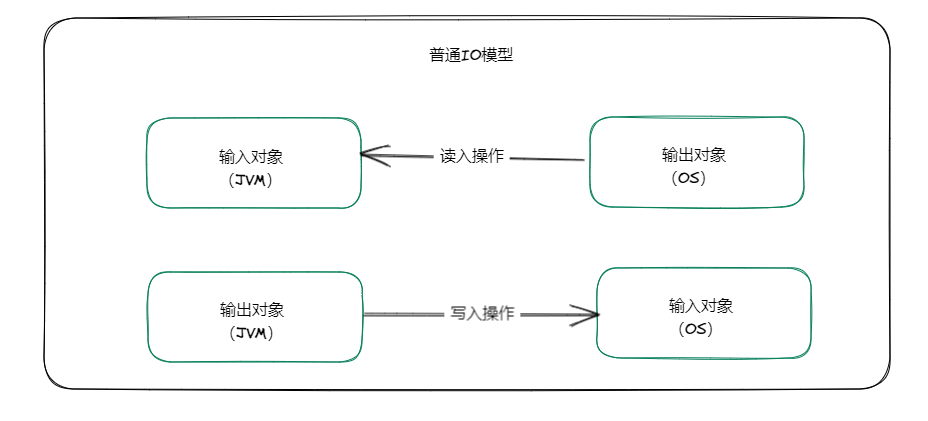
这时我们可以引入下图,如图所示,我们可以引入一个新的 IO 模型,这时,不需要再为了传输数据时创建两个对象流,我们只需要在两个通讯的对象之间,构建一个 Channel 抽象通道,将数据抽象为 Buffer ,这时我们只需要双方在该 Channel 通道中传递 Buffer 即可,我们只需要将数据放入 Buffer ,然后在通道之间传递即可。

从 JVM 内存引入直接内存和堆内存原理
如下图所示,我们以创建一个对象的原理,来引入直接内存和堆内存的原理。我们看到在创建一个对像时,包含创建对象、放置对象的引用、复制对象引用、存放对像引用,为何需要复制?因为 invokespecial 、astore 这两个字节码需要消耗两个引用,而 new 会返回一个引用,所以我们需要 dup复制一个引用,在创建对像时,需要创建一片空间,该空间如果用 c语言 来描绘,我们可以用 malloc 函数来进行创建该对象空间,同时 free 函数可以释放该空间,在 C++ 中由于引入了面向对象的概念,这时不会使用 malloc 来分配原始内存,引入了 new 操作符和 delete 操作符,new 在用 malloc 分配完内存后,将会调用构造函数和构造初始化列表,delete 会在执行析构函数后,调用 free 来释放空间。
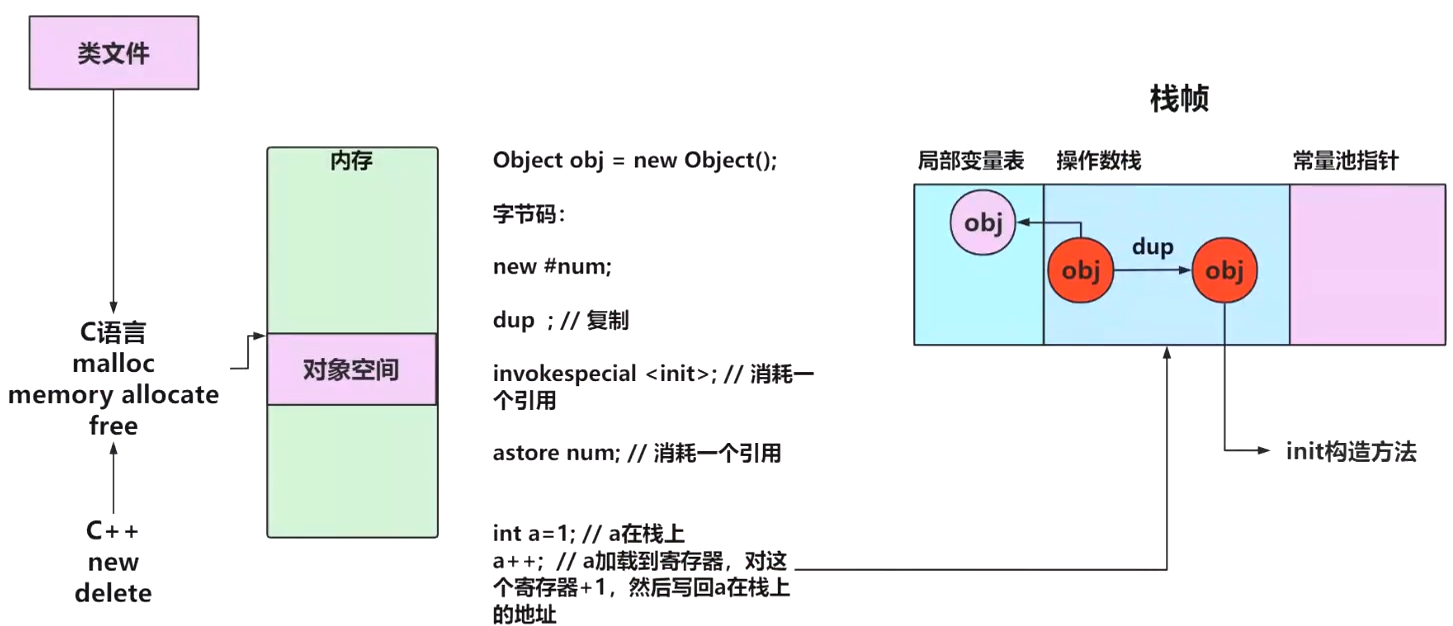
直接内存和堆内存原理
如下图所示,我们可以称:
- 在
JVM内存中分配的空间为: 直接内存缓冲区(DirectByteBuffer) - 在
JVM内存中的堆内存中开辟的空间为:堆内缓冲区(HeapByteBuffer)
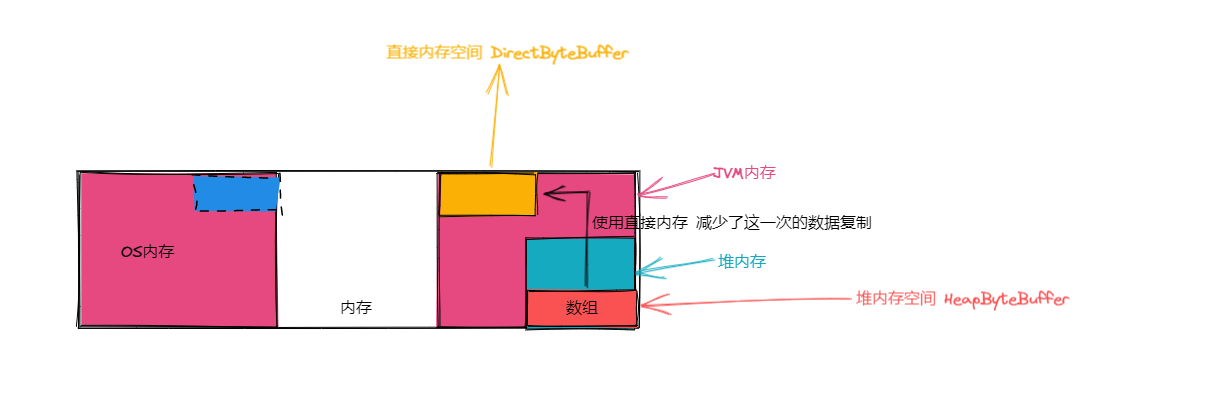






















 123
123











 被折叠的 条评论
为什么被折叠?
被折叠的 条评论
为什么被折叠?










